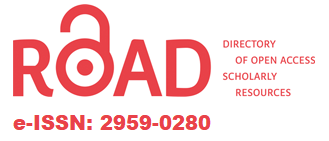Assessment Of COVID-19 Virus Infection Among Patients With Atherosclerosis
DOI:
https://doi.org/10.59480/phahs.v1i2.19Keywords:
Keywords: COVID-19: coronavirus disease caused by the SARS-CoV-2 virus., COPD: chronic obstructive pulmonary disease.Abstract
Coronavirus disease 2019 (COVID-19) is a global pandemic affecting 185 countries and 3000000 patient’s worldwide COVID-19 is caused by severe acute respiratory syndrome coronavirus which invades cells through the angiotensin-converting enzyme receptors among patients with COVID-19 there is a high prevalence of cardiovascular disease.
Patients and Methods :The data were collected from patients which had been recovered from covid -19 virus and they have to progress in the disease to have atherosclerosis and some of the patients had a sign and symptoms of COPD. A total of 125 patients were taken for this study were taken for this study including both sex male and female with different age groups all of them admitted to specialized surgical-cardiac center hospital in Erbil City in Iraq. All of them suspected to have atherosclerosis so they will be detected by angiograph in catheterization laboratory in the hospital.
Conclusion: this study demonstrated that COVID-19 virus are also significant risk factors for coronary artery disease and patients who recovered from COVID-19 have had been suffered more from that increasing the severity of disease on them.
References
- Dong E, Du H, Gardner L. An interactive web-based dashboard to track COVID-19 in real time [published online February 19, 2020]. Lancet Infect Dis. doi: 10.1016/S1473-3099(20)30120- https://www.thelancet.com/journals/laninf/article/PIIS1473-3099(20)30120-1/fulltext
- Chan JW, Ng CK, Chan YH, Mok TY, Lee S, Chu SY, Law WL, Lee MP, Li PC. Short term outcome and risk factors for adverse clinical outcomes in adults with severe acute respiratory syndrome (SARS). Thorax. 2003;58:686–689. doi: 10.1136/thorax.58.8.686 Crossref. PubMed.
- Wu Z, McGoogan JM. Characteristics of and important lessons from the coronavirus disease 2019 (COVID-19) outbreak in China: summary of a report of 72314 cases from the Chinese center for disease Control and prevention. J Am Med Assoc 2020.
- ] The world health organization coronavirus disease 2019 (COVID-19) situation report e61. Available at:-, https://www.who.int/docs/default-source/ coronaviruse/situation-reports/20200321-sitrep-61-covid-19.pdf? sfvrsn¼f201f85c_2. [Accessed 22 March 2020].
- Biasucci, L.M.; Leo, M.; De Maria, G.L. Local and systemic mechanisms of plaque rupture. Angiology 2008, 59, 73S–76S. [CrossRef].
- Corrales-Medina, V.F.; Madjid, M.; Musher, D.M. Role of acute infection in triggering acute coronary syndromes. Lancet Infect. Dis. 2010, 10, 83–92. [CrossRef].
- infections and acute coronary syndromes. J. Infect. 2013, 66, 1–17. [CrossRef] 31. Belkaid, Y.; Rouse, B.T. Natural regulatory T cells in infectious disease. Nat. Immunol. 2005, 6, 353–360. [CrossRef] [PubMed]
- Qin, C.; Zhou, L.; Hu, Z.; Zhang, S.; Yang, S.; Tao, Y.; Xie, C.; Ma, K.; Shang, K.; Wang, W.; et al. Dysregulation of Immune Response in Patients With Coronavirus 2019 (COVID-19) in Wuhan, China. Clin. Infect. Dis. 2020, 71, 762–768. [CrossRef] [PubMed.
Downloads
Published
How to Cite
Issue
Section
License
Copyright (c) 2023 Salah Hassan Yousif, Ahmed Abdulqader Abdulsalam , Sevan Hassan Bakir, Shwan Othman Amen

This work is licensed under a Creative Commons Attribution-NonCommercial-NoDerivatives 4.0 International License.
All PHAHS Journal articles are published under the terms of the Creative Commons Attribution-NonCommercial-NoDerivatives 4.0 International License (CC BY-NC-ND 4.0) which allows authors retain copyright and others may not use the material for commercial purposes. A commercial use is one primarily intended for commercial advantage or monetary compensation. If others remix, transform, or build upon the material, they may not distribute the modified material.
Copyright on any research article published by the PHAHS Open Access journal is retained by the author(s). Authors also grant any third party the right to use the article freely as long as its original authors, citation details and publisher are identified.
Use of the article in whole or part in any medium requires attribution suitable in form and content as follows: [Title of Article/Author/Journal Title and Volume/Issue. Copyright (c) [year] [copyright owner as specified in the Journal]. Links to the final article on PHAHS website are encouraged where applicable.
The CC BY-NC-ND 4.0 Creative Commons Attribution License does not affect the moral rights of authors, including without limitation the right not to have their work subjected to derogatory treatment. It also does not affect any other rights held by authors or third parties in the article, including trademark or patent rights, or the rights of privacy and publicity. Use of the article must not assert or imply, whether implicitly or explicitly, any connection with, endorsement or sponsorship of such use by the author, publisher or any other party associated with the article.










